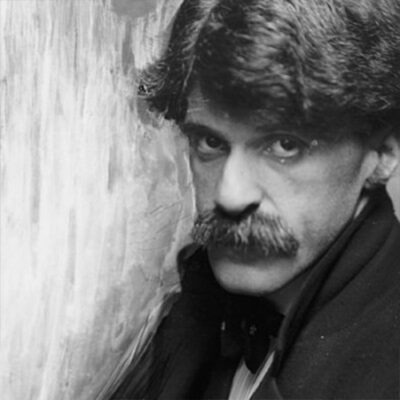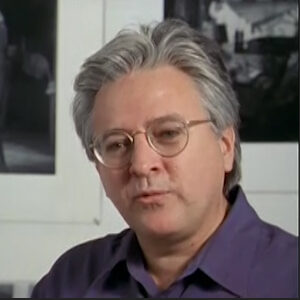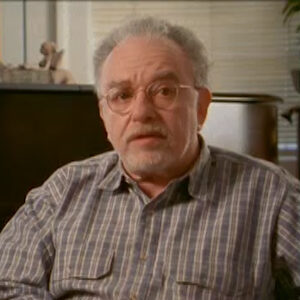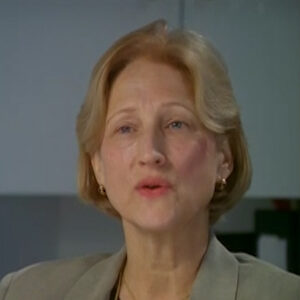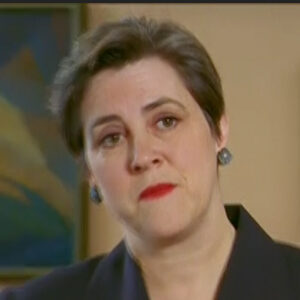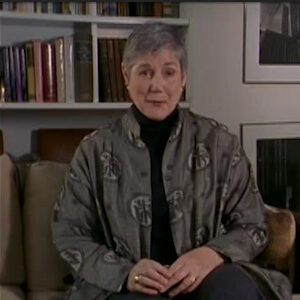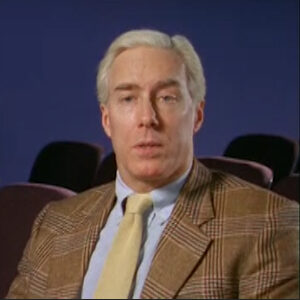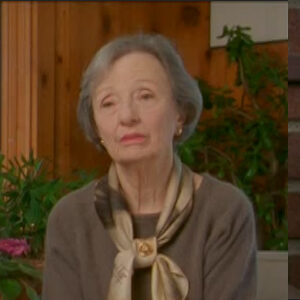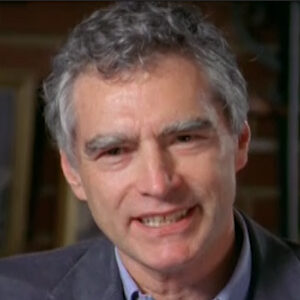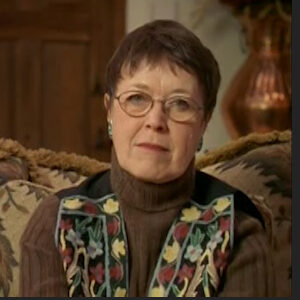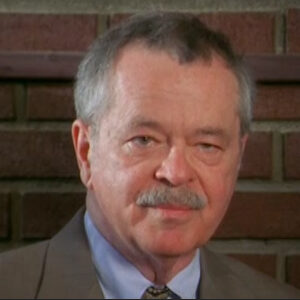Greenough: Modern European art to this country in support of American modernism. And these are just boards that have reproductions of all the works that we hope will be in the exhibition, arranged as we expect the exhibition itself to be arranged.
Interviewer: These things are going to be you each.
Greenough: Each piece of cardboard represents one gallery in the in the exhibition. And the exhibition is arranged chronologically, starting with Steiglitz, his introduction of modern European art to this country in nineteen hundred and eight, and then goes all the way up through the last exhibitions that Stieglitz organized at an American place in the 1930s and 1940s.
Interviewer: I just did a radio show. I did.
Interviewer: OK, could you tell us why? What you’re trying to do with this show?
Interviewer: What’s the what’s the theme? What do you plan to say in the show?
Greenough: Well, there have been a number of exhibitions in the years since Stieglitz, his death, that have focused on Stieglitz, his own photographs, the photographs of those other photographers that he supported, as well as exhibitions of the artists that Stieglitz supported during his lifetime. But we want this exhibition really to be a more comprehensive overview of all of Stieglitz, his accomplishments, his accomplishments as a photographer, as a gallery director, and also as a publisher.
Greenough: And so in that way, I think it will be really a much more thorough retrospective examination of Stieglitz, whose impact on 20th century American art and culture.
Greenough: So the connection between he and his aides telling him to stick with his interest in in in all kinds of artists is absolutely critical to this exhibition. He started off as a photographer and opened his gallery in New York, a little galleries of the photo session at 291 Fifth Avenue. And when he first opened that, it was primarily to exhibit fine art photographs. However, he knew probably from the very beginning of the gallery that he was interested in exploring other types of artistic expression. And Stieglitz quickly became dissatisfied with much of the pictorial photography that he was showing it at two ninety one. And he felt that many of the photographers themselves, with becoming complacent, repeating themselves and not really exploring new ways of expression. And so he tried to shake up these photographers by exhibiting other kinds of art. And he started first with an exhibition of a woman artist named Pamela Coleman Smith. But then very quickly thereafter was Steichen and various Desire’s and others helping him. He started showing some of the latest examples of modern European art. And Stieglitz realized that much of this new art, the ideas that these artists were exploring, really challenged the assumptions of many fine art photography, fine art photographs. At that time. And so he made this dialogue between the new art and the new photography to be central to the exhibitions that he organized at 291.
Interviewer: This is something that I absolutely think that it will.
Greenough: It shows, I think, from the very beginning of our exhibition, how that dialogue that Stieglitz established between Europe and America, between painting and photography, was really critical to the kind of work that 291 presented and the kind of art that would evolve out of it. Well, the exhibition was organized more or less chronologically, it’s divided into two into two parts. The first half of the exhibition, the first half of the exhibition looks at Stieglitz, his introduction of modern European art to this country with exhibitions of Matisse, Roedad Saiz on Picasso and others. And the second half of the exhibition picks up with Stieglitz is galleries that he ran in the 1920s in New York City. His gallery, the intimate place that he ran from 1925 to twenty nine and an American place thereafter. Stieglitz organized numerous exhibitions in all of these galleries that he directed, and we couldn’t possibly include examples of all of the art that he showed. It would just be far, far too great, too immense. So we’ve selected the what we felt to be the most critical exhibitions that he organized. And then within each of those exhibitions, we’ve tried to select the works that we feel best address the ideas that Stieglitz himself was trying to raise at that time.
Interviewer: The. Then, Steve, that was was particularly concerned with and it was an abstraction. Was it nature? What are some of the things that his artists.
Greenough: Were doing well, it it varies it varies through time in the teens. He was interested in some ideas in the 1920s. In other ideas.
Greenough: So I think one of the most exciting things about Stieglitz is that he he was continually rethinking his his approach to his own photography and also to the work that he was promoting by other photographers and artists of that time. In the 1920s, Stieglitz and others became very concerned with identifying this community of artists that was around them. The whole idea of defining a community of American artists was extremely important to them. Stieglitz closed his gallery to 91 in 1917. He and O’Keefe began living together in 1918 and between 1918 and 1924 and twenty five, Stieglitz concentrated to a great extent on on creating his his own work.
Greenough: Well, Stiglitz, I think from probably from his childhood, thought of himself as as not conforming to accepted standards, either of behavior or expectation. He very much saw himself as a rebel, as someone who was outside of society, who really wanted to question and provoke new ideas for people. He saw his his career in photography. I think as someone who would challenge the accepted notions of what constituted a photograph from what photography can and should be about. And very much. This is a this is something that carries throughout his career, his continually setting himself apart from how other people see and perceive the world.
Interviewer: Can you give us some more examples of it being a bit of a rebel like his?
Interviewer: Connection with the various ways in which she manifested itself.
Interviewer: Maybe a little bit about the different ways in which he would build.
Greenough: Well, I mean, you can. Decade by decade, you can pick out examples of where Stieglitz very consciously set himself apart from from other people who were involved in the same activities that he was. For example, the whole photo session, Stieglitz saw the photos obsession as as a group of photographers who were succeeding from other pictorial photographers of the time who would have higher expectations for what their photographs should be about. The very word secession, I think, indicates the rebellious nature of Stieglitz in the nineteen ten tens during this First World War. The seven artist was a group. Excuse me. Say that definitely during during the First World War. Stieg. During the First World War, Stieglitz was closely involved with a group of artists and writers who were connected with the publication of the Seven the Seven Arts, and they very much saw themselves as it as a group who would challenge existing ideas about the nature of art within American society. In the 1920s, Stieglitz organized an exhibition called The Seven Americans, in which he at that point brought together for the first time the group of artists that he would champion. From then on. And once again, he wanted to show at that time when most other galleries and museums in New York City were very much focused on showing modern European art. Stieglitz wanted to stand up and say, no, it’s the modern American artist who also needs our support, our recognition, who is producing work equally as strong and equally as valid as the European artists.
Interviewer: Tell us something about the, uh, his kids need to be to be to be famous, to be a leader.
Interviewer: Something about his character. They’re that way.
Greenough: Stiglitz was someone who always had a very clear sense that he was going to be an important person even from the very beginning of his career.
Greenough: You see him saving every scrap of information about. About his life. He saved all the letters that he received when he was a student in Berlin in the eighteen eighties. He saved all of the opera programs for the operas that he went to see. He saved stubs for museum entrances, entrance fees. And it’s almost as if he knew that at some point somewhere down the road, a library or museum would be interested in collecting this material. And in letting students and scholars and others study it in the future. He was very clear, very certain that he would have an important place in history and that he should be studies and studied and his accomplishments should be analyzed thoroughly and thoughtfully.
Interviewer: Now, this let’s your first the first gallery, which is going to be to making one of the early to show that something about Steichen, how they work together and and how we worked out after that.
Greenough: Well, Stieglitz opened his gallery a little galleries of the photo session at to ninety one, which came to be called just to ninety one. He opened that in 1985 and initially just showed exhibitions of the photographers connected with the photo session or other pictorial photographers from England and and the rest of Europe.
Greenough: But he quickly began to feel that they were becoming complacent, that they were assuming themselves to be much better than Stieglitz thought that they were, and that they weren’t pushing their art. They weren’t challenging it. And he began to think about exhibiting work by other artists from the time Edward Steichen had always been very helpful and supportive for Stieglitz. His efforts at two ninety one, Steichen had initially designed much of the interior space at two ninety one. And Steichen was was a photographer who had spent considerable periods of time in Europe and had made close friendships with many European artists at that time. And Steichen and Stieglitz obviously spoke a great deal about other kinds of art that should be exhibited at 291. And so beginning in nineteen hundred and eight, Steichen starts sending over to the United States a series of exhibitions of work by the leading French artists of the time. Steichen was a very close friend of Rodin. And so one of the first exhibitions that Steichen Steichen organized was an exhibition of road dance drawings. And this was shown at at 291 in nineteen hundred and eight. And it was a very scandalous exhibition in the minds of many New Yorkers at the time, not only because the drawings seemed to be very unfinished, but also because they were clearly studies of nude models who had been prancing before Roedad in his in his studio. But many of the most vociferous attacks on the exhibitions that Stieglitz organized at two ninety one were from the photographers themselves who didn’t understand why their gallery, which they had thought would be devoted to exhibiting fine art photography, was all of a sudden exhibiting work by non photographers.
Interviewer: Something.
Interviewer: You belong to.
Greenough: Steichen was extremely important to Stieglitz in organizing the exhibitions at 291 from about nineteen hundred and eight up until the time of the Armory Show in 1913. Steichen was was critical in organizing the exhibitions of Roedad Motifs stays on as well as as well as others. But Steichen own understanding about modern art really didn’t keep pace with this rapidly changing time. And Steichen had less of an a keen appreciation for the work of someone like Picasso, who was, of course, becoming critically.
Greenough: Steichen had much bigger. Steichen had had less of an understanding about Picasso’s work than some of the other people who came to be associated with two 91. So around the time of the Armory Show, Steichen became less critical, less involved in organizing exhibitions for Stieglitz. And other younger people started to take over that that place that Steichen had once had. People like Marías Desire’s the character caricaturist or Paul Havilland. They became extremely important for Stieglitz and helped Stieglitz to organize some of the really critical exhibitions that occurred 1912, 1913, 1914, in 1915.
Interviewer: Could you tell us something about the connection that you felt?
Greenough: Well, Stieglitz quickly came to see that this new art that was coming out of Europe raised many challenges for American artists in general and also for photographers. And he made this dialogue between painting and photography absolutely fundamental to the exhibitions that he organized at 291. And I think that you can see that particularly well in the series of exhibitions that he organized around the time of the Armory Show in 1913, Stieglitz was peripherally involved in the Armory Show. He lent his name as one of the people supporting it, but he didn’t really have much involvement in the selection of it, but rather, he organized a series of exhibitions at two ninety one, which were in direct response to the exhibition at the Armory Show right before the Armory Show opened. He had an exhibition of John Marin’s watercolors and clearly he was trying at that point to assert the importance of American art within this new mixture of modern European art was getting considerable amount of attention at the Armory Show, and Stieglitz wanted to make sure that American art also received its attention during the time of the Armory Show.
Interviewer: Oh, yes. Yes, yes. I’m delighted that everything on.
Greenough: He and O’Keefe began living together in 1918 and between 1918 and 1924 and twenty five, Stieglitz concentrated to a great extent on on creating his his own work during that time, particularly his photographs of of O’Keefe were made during that period. But he also, in the early 1920s, began to organize exhibitions of his own photographs, as well as exhibitions of O’Keeffe’s art and.
Greenough: Well, here was a major exhibition of mainly modern European art in this country. And Stieglitz, prior to that time, had been the only person who had shown any interest in this country on a really serious level of showing that work to the American public. So in that way, it was a vindication of his efforts. However, Stiglitz himself felt that the Armory Show itself sort of took on a life of its of its own. He felt that there became to be too much hoopla in connection with the Armory Show, too much sensationalism, really, without enough serious thought about what this new art really represented. And also, in the wake of the Armory Show, several other galleries began to be founded in New York, which began to exhibit modern European art.
Greenough: And these were very much of a challenge for Stieglitz. No longer was he the only place where one went to in New York to see modern European art, but one could go to other galleries. So his his position as the pre-eminent leader of this movement was very much challenged. But I think it’s also interesting to note that around the time of the Armory Show, Stieglitz organized a series of exhibitions which were obviously very carefully conceived as his response to the Armory Show right before the Armory Show opened. He had an exhibition of John Marin’s watercolors. And clearly, he was trying to suggest that while the Armory Show itself was focusing a lot of attention on modern European art, a modern American art needed to be looked at and examined justice carefully during the Armory Show. He exhibited his own photographs at that time, as if to say the Armory Show is showing you what modern painting is all about. And here these are my photographs to show you what modern photography is, is all about. And then immediately after the Armory Show, he exhibited work by the one of the stars of the Armory Show, Francis Kabeer. And what’s also interesting about this series of three exhibitions as well, is that all of these artists in the work that Stieglitz showed it to, ninety one showed their depictions of New York City. So in the course of this, these three exhibitions, one could see a modern American artist looking at New York City at that time, Stieglitz, his own photographs of New York City, and then Cobie, a European modernist. His response to the vitality of the New York environment. Well, after the Armory Show, he very clearly wanted to separate himself from the other galleries that were springing up in New York that were showing, what do we say the more traditional or obvious European avant garde work? And Stieglitz began to investigate a number of other other kinds of art that he felt were extremely influential on modern European art. He held the first exhibition in this country of African art because he and Marius Desire’s and others recognized how important African art had been to Picasso and others. At the same time, he also organized an exhibition in 1914 of Brain Cuzzi, a sculptor, showing his his response to some of these new ideas about form, and that had been first introduced by Picasso and others. And then immediately after those two exhibitions, he held a very small exhibition at two ninety one, probably really more of an installation, not as opposed to an exhibition of African art placed in conjunction with a work by Picasso or work and a work by brain cuzzi, as well as a great big business to that or wasp’s nest that was in front of it all. And clearly in this exhibition, he was trying to challenge people’s ideas about the nature and culture, about educated art and and art produced by other non Western people.
Greenough: African art, instead of ethnography, show that it was absolutely a very novel idea to present was showing African art within the confines of an art gallery was a very novel idea at the time.
Greenough: The exhibition that Stieglitz organized in 1914 of African art was the first exhibition in this country that showed African art within within an art gallery. But Stieglitz did it because he recognized how important the ideas that were in bodied in African art. How important that had been to Picasso and other modern artists of the time.
Interviewer: Some of the artists who were close to two Stieglitz like become here and Desire’s and then what happened during World War One?
Interviewer: That they left to get us to World War One.
Greenough: By 1914, 1915, some of Stieglitz, his colleagues, felt that he was beginning to run out of steam as they as they put it, because he was no longer the only place in New York where one could see modern European art. They felt that he was drifting somewhat in these years. And in order to reinvigorate what had been this really lively scene at 291 people like Marías Desire’s Frances Kaavya, Agnes Ernst Meyer and others got together and began to publish a magazine that they called to 91, which really included some of the most innovative art from that from that time. But Kaavya published in Two Ninety One, a series of abstract portraits of friends and colleagues at the two one gallery, a portrait of Stieglitz, which depicted him as a as a camera, actually as a as a broken camera, a portrait of a young American girl that depicted her as a spark plug and other abstract portraits that really questioned the notion of portraiture at this time. But that also introduced the idea of the machine in in art and recognized its its importance. But Kaavya was very close to Stieglitz during this time, but they had quite different ideas about about where art was was going.
Interviewer: Something is wrong.
Greenough: It’s Stieglitz whose primary purpose in introducing modern European art to this country was to challenge American artists, American photographers, American painters, sculptors and others. And at the same time that he was showing people like Picasso, Matisse and Suzanne. He was also organizing exhibitions of work by younger American artists, championing them, giving them a place to show their work to the New York public.
Greenough: And Stieglitz felt that particularly by 1915, 16 and 17, that this work by the younger American artists was really beginning to come together into some of the strongest statements that were being made at this time. And in 1915, 16 and 17, Stieglitz organized another series of exhibitions of the work of younger American artists. Marston Hartley was shown during that time Hartley’s abstract portraits that he had made in Germany right before and during the First World War were shown then. And these created a great sensation. O’Keefe referred to seeing the exhibition as being comparable to listening to a military brass band in a closet. So overwhelming was the sight of this kink. Caffeine is color and noise that she felt emanating from the works themselves.
Interviewer: Wouldn’t say if that doors like so I thought it was.
Interviewer: Yeah.
Interviewer: Settle down, guys.
Greenough: He hardly went to Europe before the First World War. He went first to Paris, where he met Gertrude Stein and others. But he didn’t really seem to feel too at home or too comfortable in Paris.
Greenough: And he went to Berlin, where he clearly, from his letters to Stieglitz and others at the time, just fell deeply in love with with Berlin, with the pageantry of the city, with the color of the city. Also with many of the military officers, the parades and others and other events that were happening at that at that time.
Greenough: Stieglitz was helping to support Hartley during this period, sending him money. But as the war intensified, it became more and more difficult for Hartley to receive the checks that Stieglitz was sending. And it was really only because of the difficulty that Hartley had in getting his money from Stieglitz, that Stieglitz was actually able to finally bring Hartley back to this country. When he came back here in 1915 16, Stieglitz organized a couple of exhibitions of Hartley’s paintings, which were actually not very well received by the critical press at that time, primarily because that the the German nature of these paintings and their seeming celebration of of Germany at this time was not obviously a very popular cause for Hartley to be to be champing. But the pictures themselves formally and as far as their use of color and their use of abstract form to create portraits, were very strongly received by the other artists associated with 291 at that time.
Interviewer: What’s happened?
Interviewer: It’s hardly the during the during the 20s and 30s. What happened?
Greenough: Well, hardly. It was a rather peripatetic figure. I mean, he wandered from place to place throughout the 1920s and 30s after he got back from Berlin. He went to Provincetown. He traveled extensively in the late teens and early 20s. He went out to New Mexico for long periods of time. He went back to Europe in the 1920s. He only really came back to this country in the 1930s. And then really only after long, long pleas from Stieglitz to come back home to the United States. And to really firmly embrace America as as as his subject. Hartley was obviously an artist, too, had a difficult time settling down in in any one place.
Interviewer: Could you tell us something about what happened? Something about. About Paul’s friend. I think this is about. About the time that the post front came into the picture, Strand began to come to 291.
Interviewer: I was talking I’m sorry, could you start?
Greenough: Strand began to come to two ninety one in the well in the early nineteen. Nineteen to the.
Interviewer: So we can get this one thing worse, because, you know. OK. OK. Down here.
Greenough: This strand was first brought to 291 when he was a student at the Ethical Culture School in New York City by his teacher, Lewis Hine. And he continued to go back to 91 in the early nineteen, 10, 11, 12, 13, 14. He was a regular visitor to two ninety one and came to be in very influenced by the art and the new ideas that he heard discussed there in 1914 and 1915. He showed Stieglitz many of the photographs that he was taking at that time, and Stieglitz really felt that Strand was the first photographer who had consciously addressed the challenges that modern European art, modern art in general posed to photography and was one of the first photographers to really begin to evolve a new understanding of what they at the time referred to as pure photography or what has come to be called straight photography. Photographs that don’t strictly emulate paintings, but rather concentrate on recording the essence of the of the thing itself. And Stieglitz gave a Strand an exhibition in 1916, which was really the beginning of Strand’s career as as a prominent photographer of that time.
Interviewer: Could you talk a little bit more about.
Interviewer: That spreads. What was what was really new about what Strand was doing in. She was so excited about him. He mentioned it. Gives a little more about this very important.
Greenough: Strand was doing a number of things in this in his photographs at this time. He was, first of all, exploring abstraction and photography and a series of really bold, innovative photographs that he made in 1916. He showed how one could create photographic abstractions without alter altering or manipulating the print itself, but rather by focusing very tightly on details in the natural world that they could be extracted from that world and presented more as pure form as opposed to functioning or functional objects at the same time. You also made a series of really bold photographs of people on the streets of New York, portraits of people that were taken without them being aware that their pictures were actually being recorded. And these were pictures of people who prior to that time had not really been presented within the hallowed halls of an art museum or or even a gallery at that time. The blind beggar woman, for example, or the sandwich board man on the streets of New York City, their portraits that have an amazing power to them, also strength and dignity as well. They’re not sentimental images by any means. And these were photographs that Stieglitz felt was particularly powerful statements of what the new photography could be all about.
Interviewer: Lots of things spread.
Greenough: They clearly were influencing each other at this time. One can see them exploring similar or similar views. Stieglitz in 1915, 1916, made a series of studies out the back window of two, one that are really just of a formal arrangement of planes, of forms and structures in the New York City skyline that are close to images that Strand was also making using New York and exploring its strong, dynamic, formal properties. And in the 1920s, they would continue to explore similar subjects. Stieglitz, of course, made his monumental portrait of Georgia O’Keeffe beginning in 1918, a series of more than 300 photographs of O’Keeffe and Strand. Perhaps in answer to that, some might say in imitation of that, also made a series of photographs of his wife, Rebecca. At exactly the same time that are formerly close to what Stieglitz was doing with with O’Keefe. Although I think they have a much different emotional content.
Interviewer: They were very different people’s.
Interviewer: And what they meant were secrets, were they? Something.
Greenough: Well, Stiglitz first photographed O’Keefe in 1917 when she came from New York. Scuse me. Stiglitz first started photographing O’Keeffe in 1917 when she came from Canyon, Texas, where she was teaching to New York City to see an exhibition of her art.
Greenough: That Stieglitz had hung it to 91 and he made a few portraits of her. Then during that visit, which really seemed to show a shy, somewhat hesitant young woman, really, she really looks like what she was a schoolteacher from the plains, the plains of Texas. She often has a slightly bemused look on her face at that time, as if she’s not quite sure what to make from all this attention that Stieglitz and others are paying to her. In 1918, O’Keefe moved to New York City and she and Stieglitz began living together there shortly thereafter. And Stieglitz became consumed with photographing O’Keefe for a long time. He had wanted to make what he came to call a composite portrait of someone, a portrait that would document would record a person’s many moods, their many different selves over their whole lifetime, a portrait that would begin at birth and go all the way to someone’s death. He had started to do this with his daughter Kitty, when she was born. But supposedly his first wife objected to all the attention that Stieglitz was paying to Kitty and he abandoned the project. But when O’Keefe moved to New York, Stieglitz really had an ever present model, and he began photographing her with a fervor and intensity that he hadn’t done with any subject for a considerable amount of time between 1917 and 1937 when he stopped photographing. He made more than 300 portraits of her, but the vast majority of those were made during the first few years of their relationship. Stieglitz quickly came to believe that a portrait of someone didn’t just include studies of their of their face, but that someone’s body, their hands, even their feet could be as indicative of personality as as the face or the head itself was. So he began to photograph all of O’Keeffe’s body, her torso, her feet, her legs, her arms and particularly her hands. He was entranced with her very beautiful hands.
Interviewer: Could you do these photographs to the public?
Greenough: Students first exhibited the portraits of O’Keefe in 1921 at an exhibition of his work that he held at the Anderson Galleries in New York City. And their reaction was extremely strong, extremely intense. People felt that Stieglitz had really succeeded in capturing an extraordinary depiction of of O’Keefe and of a woman. Indeed, it has been with Stiglitz, his objective, I think, really to capture what he felt.
Interviewer: Yeah.
Interviewer: We were talking about the first time you showed them in public and the reaction. And then maybe we can talk about. The show O’Keeffe’s work.
Greenough: And the connection that was made with Stieglitz exhibited the photographs, his portraits of O’Keefe in 1921 at the Anderson Galleries, and he exhibited a large number of pictures of O’Keefe in addition to other photographs of the other. Yeah, yeah, yeah.
Interviewer: The first reaction was a lot of stuff in the newspaper.
Greenough: Stiglitz exhibited his portraits of O’Keefe publicly for the first time in 1921 at the Anderson Galleries in New York City. Although they were only a small portion of the exhibition, he also included some of his earlier photographs of New York City and other subjects. The portraits of O’Keefe were were very widely acclaimed and commented upon by both Stieglitz, his friends and colleagues, but also by the press. Henry McBride, who was a popular critic at the time, said that O’Keefe, as a result of these photographs that were exhibited at the Anderson Galleries, became a newspaper personality. And to a great extent, it did establish O’Keefe as a celebrity of of of sorts. And it was a it was a really rather novel way on Stieglitz as part to reintroduce O’Keefe to the New York audience. He had shown her work, of course, at two 291 in 1916 and 1917. But then he hadn’t shown any exhibitions of her art until 1923 when he organized another exhibition of his photographs and then also an exhibition of O’Keeffe’s paintings. And many of the critics, when they responded to O’Keeffe’s paintings, when they saw them in 1923, in 1924, seemed almost as if they were thinking more about Stieglitz, whose portraits of O’Keefe in the nude than they were actually looking at O’Keeffe’s own paintings. Many of their descriptions of the swelling forms and voids, for example, seemed more appropriate almost when applied to Stieglitz, his portraits of O’Keefe than they do the particular paintings by O’Keefe that were shown at that time. And O’Keefe herself clearly felt burned by some of the critical reaction to her paintings in 1923 and 1924, felt that the critics were overemphasizing the sexual nature of her pictures and and not looking at them carefully or thoughtfully. And so she seems very consciously in the middle of the 1920s to have changed her art and to have started to explore what she thought might be cooler subjects not working so much in abstraction, which she felt had had gotten her into some of this, some of the more Freudian interpretations, but rather to focus on close up studies of fruits and vegetables, studies of Barnes. And of course, it was also at this time that she began to do her highly magnified views of flowers, which, of course, only gave the critics more fuel for their Freudian interpretations.
Interviewer: Why do you think the.
Interviewer: O’Keefe did allow Stieglitz to photograph her. So in. So kind of the situation.
Greenough: Well, I think you have to remember that when Stieglitz began photographing O’Keefe in 1918, he was at that point the most important person in the New York art world, in the American art world at that time.
Greenough: He had organized numerous exhibitions and had helped to promote the work of both European and American modernist artists. And of course, he had the ability and would promote O’Keeffe’s work tremendously. O’Keefe at that time was a schoolteacher from the plains of Texas when Stieglitz began photographing her. She was a young and very unknown artist, and she was deeply in love with Stieglitz and he deeply in love with her. And so, of course, she would take direction from him. Of course, she would want to help him create works of art to act as as a model from him. And in later years, she willingly and freely admitted that Stieglitz did ask her to pose in certain ways, ways that she might have found uncomfortable or unnatural. There’s a wonderful quote where she said that Stieglitz even asked her to stand on top of a radiator in front of a window. And she remarked, Well, that was difficult. Radiators don’t intend you to stand on top of them. And I think that shows both how much she was willing to help and to aid Stieglitz in this project, but also that it was very much Stieglitz, his project. The portrait that Stieglitz took of O’Keefe are very much his interpretation of what a woman was, what a woman was to him, and less O’Keeffe’s projection of who she was.
Interviewer: So what was.
Interviewer: Wasn’t Keith, was a Keith.
Interviewer: Surprised at the kind of reaction.
Interviewer: I think she was very surprised by it. I don’t think that she really my question. OK. That’s right.
Greenough: I think that O’Keefe was very startled by the reaction to Stieglitz, whose portraits of her and particularly startled by the power that stick with his photographs, would have to shape her public persona.
Greenough: Indeed, people, I think, thought that the pictures that Stieglitz had taken of O’Keefe were really an objective record of who O’Keefe was. And yet, if you read O’Keeffe’s letters from that time or you look at other photographs taken of her from that time or even other painted portraits made of her at that time, you see a very different person emerging in those than you do in Stieglitz. His photographs, Stieglitz was recording who O’Keefe was to him, but not necessarily who the rest of the rest of the world saw. But O’Keefe was particularly stung, I think, by some of the public reaction to the to the photographs. And she I think even more so was instructed, do the power of that photography could have to define a public persona. And after the mid 1920s, she became much more guarded. I think in how she or how and when she would let herself be photographed, because she wanted to make sure that she could control the way that the world saw her and the way that the world understood both O’Keefe as a person and O’Keeffe’s.
Interviewer: Art, you told us that on her or the.
Interviewer: Stieglitz.
Interviewer: Well, there are various reasons for people to write still and why he said that he started doing.
Interviewer: Why do you think that he got interested in clouds? He didn’t do as much with it with the PPIF.
Greenough: That’s a complex question.
Greenough: Steagles began photographing clouds in 1922. He always remarked that these specific thing that propelled him to start to photograph clouds was a comment that was made by a colleague of his, Waldo Frank, where Frank had written, or Stieglitz thought that Frank had written, that the power of Stieglitz as photography was due to his ability to hypnotize his subjects and to extract from them the emotional response that he Stieglitz wanted.
Greenough: And so Stieglitz decided that he would start to photograph clouds in order to prove that his ability to create fine photographs wasn’t at all due to some strange hypnotic power. After all, who could control the clouds as they drifted across the horizon? Certainly not a mere mortal like like Stieglitz.
Greenough: But as he came to get involved in the project, he also began to see that it was a way of exploring abstraction in photography without in any way manipulating the photograph. The photographs themselves or distorting the scenes in front of his camera that he could use the abstract forms of the clouds themselves to express some of the some of his emotions at the time, his feelings of joy, of sorrow and of sadness, as well as other deeper feelings that he was experiencing at that moment.
Interviewer: When did photography become really popular and available to the general public?
Greenough: Photography became popular. Well, it’s right again.
Greenough: In the 18 80s, there was a revolution in photography with the invention of the Kodak camera and other small handheld cameras. And at the same time as that occurred, there was also the development of a photo finishing industry.
Greenough: So all of a sudden, it became possible for people of middle class means not only to own a camera, but also to take pictures. And with those two inventions in the eighteen eighties and eighteen nineties, photography just took off. And many, many people owned cameras and started taking pictures for themselves and their and their families. Snapshots just as we take today.
Interviewer: And what does something about peripheral photographers. There were commercial photographers, something more about the photograph and see what else was going on.
Greenough: Well in the eighteen eighties and eighteen nineties, it was a period of great change in photography.
Greenough: There were, of course, commercial photographers who had large studios in all of the major cities, as well as in most smaller towns where people could go to have portraits taken. However, with the rise of the whole the amateur movement in the eighteen eighties and nineties that was brought about by the introduction of small hand-held cameras. All of a sudden, photography became accessible to this huge new mass audience. In reaction to this increased accessibility, one finds a small group of photographers who very much wanted to separate themselves from the general, you know, run of the mill amateur photographer who wanted to prove that their photographs were capable of personal artistic expression. And this is a movement that occurred in photography in the 80s and 90s in this country and in Europe. In England. Really, it was a widespread phenomenon.
Greenough: Just a little bit ago, before you were these the people became the people in the eighteen eighties and eighteen nineties.
Greenough: Photographers who did want to assert the artistic merit of photography have often been sort of loosely lumped under that the title of pictorial photographers. These were photographers who strove to make fine art photographs, who tried really to make their photographs and embody feelings and emotions to express their response to the to the world around them and also to really firmly prove to the rest of the public that photography was capable of artistic expression. And these photographers often called themselves pictorial photographers. They banded together in societies in this country and in Europe. Stieglitz, whose photos obsession was one of those groups in Europe. There were groups like the linked ring, which consisted of a small group of photographers who had to be elected in order to become a member of the linked ring. And these were really the sort of most refined fine art photographers from that period.
Interviewer: Well, a little bit about the sequence of what he was doing in Europe.
Interviewer: And then when he came back, the kind of pictures that he was taking, where he fit into this whole picture.
Greenough: Well, when Stieglitz began to photograph in the eighteen eighties, this was when he was in in Germany. Start again. That’s all. Backer’s Stieglitz began to photograph in Germany in the eighteen eighties. He initially learned photography by studying with a very well-known photo. Kamins, Termine, Vilhelm, Voegele and Stieglitz learned photography much more from a sort of technical and scientific point of view. He didn’t come to it as an amateur photographer who gradually became more and more obsessed with the medium, as did so many other photographers of the time did. But he came to it rather through the science of photography. And in this way, he had from the very beginning of his career, a really remarkably thorough grounding in technique and in process. Secrets was probably one of the most gifted technicians of photography that there ever was. He explored and made more different kinds of photographic prints than almost anyone else of his of his period. Stieglitz began to get involved with the pictorial movement in the late eighteen eighties. Initially, at first, through correspondence with other figures who were actively involved in the field, people like Peter Henry Emmerson and others. He came back to this country in 1890 and decided that the state of American pictorial photography was sadly lacking in comparison to what he had seen in Europe and really set about to to change that and to become a leader in the pictorial movement in this country in the 80s, 90s.
Interviewer: What was what was this?
Interviewer: With what is thought. Yes. OK. Good for you. Yes.
Interviewer: The central focus on purpose was life and work and the time he returned to the U.S., something like that. He was OK. Could you tell us about the his wife?
Greenough: Once he returned from Europe as well, Steve. When students came back to this country in 1890 and felt that the state of American photography was really sadly lacking, and he spent really the next 15 to 20 years devoting himself towards establishing towards proving that photography could be an art, that when in the hands of a capable, capable, gifted photographer, that photographs could be as expressive of feelings and ideas as any other kind of art form. And he tried to do this through exhibitions that he organized, through the periodicals that he edited. At that time, first he worked for one called the American Amateur Photographer, and then he began working with camera notes and finally started publishing his own periodical camera work where there was a little bit about camera work.
Interviewer: I interrupted you us a little bit about camera work.
Greenough: Camera work was probably one of the most sumptuous, beautiful periodicals ever devoted to photography or indeed to the fine arts in general. Stieglitz began to publish it in 1980 to the initial design was done by Edward Steichen, and it was something that he printed 50 issues of roughly three or four issues each year between 1982 and 1917. And each issue was very carefully, beautifully printed, beautiful type. But in addition, many photo gravure reproductions were included in the camera work volumes of many of the most important photographers of the time Stieglitz, Steichen, Gertrude, case of Beer, Seelie and and others.
Greenough: And often the photograph your reproductions were really almost as beautiful as the original photographs themselves. They were truly extraordinary in their quality.
Interviewer: The little bit about secrets, women artists with secrets.
Greenough: Stieglitz always was very accepting of of women artists, women photographers. When he formed the first recession in 1980 to Gertrude case, Beer was one of the founding members of the of the photo session. And he believed strongly that women, women artists should have a chance to exhibit their work on an equal footing with with men. And he often held exhibitions that included a fair number of women photographers. In addition to Gertrude, case of beer and brakemen was another photographer that he championed a lot at this time. Once he began exhibiting other non non photographic kinds of art, he also showed a work by an artist, a woman named Catherine Rhodes. And then, of course, there was Georgia O’Keeffe. And for Stieglitz, it was extremely important when O’Keefe came into his life. The fact that she was a woman artist for Stieglitz O’Keeffe’s seemed to confirm his belief that, first of all, it would be possible for there to be an indigenous American modernist artist, somebody who could develop as original and as expressive a form of art as the European modernists were doing. But but derive this from the American experience without having to go to Europe. But it was equally important to Stieglitz that O’Keefe was a woman artist because he felt women had something distinctive to say and very, very interesting.
Interviewer: What was the how Stieglitz work in the early making of this symbol and how is it different from the other pictorials?
Greenough: Many pictorial photographers at this time favored highly manipulated processes. They reasoned that if their photographs were to be set. It is works of art. They should look as much like paintings as possible, that they should not be sharply focused, that they should be more softly focused, that they should be less explicit and more evocative. And they believe that in order to achieve this, it was better if they were more sort softly focus and also if the prints themselves looked more like paintings, if they perhaps had some of the color of of paintings. So they emulated the style and the subject matter of many late 19th century symbolist paintings and others stupas. His photographs are significantly different from any pictorial photographers, although he occasionally experimented with manipulated techniques and occasionally made come by chromate prints. These were really very rare and most of his photographs were were emphatically of their time.
Greenough: In other words, whereas many pictorial photographers sought out evocative landscapes or sort of Misty is Thieriot women, Stieglitz often turned his camera on the subjects that were immediately around him, and particularly New York City.
Greenough: And he was especially interested in photographing New York, showing that it was a place of change, of movement and of energy. And in this way, his photographs are really significantly different from those of other photographers, other pictorial photographers of the time. And they were recognized as being somewhat different from from the rest of the work of the photos, the session and others.
Greenough: I think that’s something that period that you don’t want to overstate, because to a certain extent, you know, Stieglitz has has refined the view that we have of him now and cut out many of those more manipulated photographs. So it’s it’s one needs to be very careful when when thinking about when talking about Stieglitz not to completely buy into the myth that he established for himself later on in his life and later on in his life. He would have liked us to have believed that he never made any manipulated photographs. But that’s not true. He just destroyed many of them so that we wouldn’t have the evidence of that.
Interviewer: Well, there was a radical change at one point, really, where he really reacted against these things he has written at the time.
Greenough: Oh, absolutely. When Stieglitz really started getting excited, interested, intrigued with modern European art, he began to see that the work by his fellow pictorial photographers as being very outmoded and absolutely felt that it was important to reject this fuzzier earlier style and search for a kind of photography that would explore the inherent cat, what Stieglitz believed to be the inherent characteristics of photography itself.
Greenough: Justice. The new pure painting was looking at pure form and pure color. So Stieglitz believed that the new kind of photography should investigate those intrinsic properties of camera vision and and the photographic print strand felt this way, too.
Greenough: Paul Strand came to feel this way by 1915 and 1916, although Strand himself also started out as a pictorial photographer in nineteen, ten, eleven, twelve. Many of his photographs had their roots in that earlier symbolist inspired style.
Interviewer: Could you tell us something about 1987 and why it was an important year sequence and what happened?
Interviewer: What was the significance that occurred on the way?
Interviewer: Something about the research and his story about photographing jurors and the fact that he didn’t publish it. What is it about his picture? And this was in 1970.
Greenough: Stieglitz and his first wife went to Europe and Stiglitz told the story many years later, his first wife had booked. Passage in the first class section of the of the boat. But he Stieglitz didn’t like that refined air and often used to spend his time walking around and looking at the people in other classes of the boat and the other sections of the boat. And he said that one day as he was walking around the boat, he looked down into the steerage section and saw a photograph that he believed expressed, as he said at the time, his feelings about. About life at that moment. And as he recalled later on, he rushed back to his camp, to his cabin. Got his camera. Came back. And most of the people were still in the same position that they had been in. When he’d first seen them and he said he took a photograph whose forms expressed his his feelings about. About life. And if you listen and read, Stieglitz says account from the time he talked.
Interviewer: Could you tell us something in the in the 20s here about the search for a definition of America and the whole search for the great American singer for the Stieglitz, his feelings about how you could find America?
Greenough: I mean, I think that he hadn’t really done enough on that other people. So if you could tell something, encourage, you know.
Greenough: The First World War was a was a watershed for for many people and for Stieglitz in particular, many people felt that the destruction that had occurred had occurred during the First World War was evidence that America couldn’t just blindly follow Europe any longer. That Americans needed to respond to their own innate. Excuse me. Going back up a second. Yeah. That Americans needed to express not an idea of culture that had been transplanted from Europe, but instead they had to express their own life, their own landscape, that it was no good simply to copy European styles anymore, that they had to and instead find an American style, find subjects and ways of expressing expressing them that were expressive of the American spirit.
Greenough: And Stieglitz was very much supportive of this. He, too, felt that Americans needed to search in their own lives for an expression of the American spirit. And many of the Stieglitz artists in the 1920s really went back to their roots, went back to their native landscape that they had grown up in and explored it, mined it for subjects that would be expressive of 20th century American life.
Interviewer: The film is something to behold.
Interviewer: When you started the recreation of a community with taking pictures of each other, you see.
Greenough: Well, in the in the 1920s and I think you can see this, especially in our exhibition, that we’re organizing American artists really for the first time began to think about and respond to much of the new art that they had seen in the first two decades of the 20th century by the 1920s. They had, to a great extent, consolidated the lessons that they learned from Suzanne Picasso, Matisse and others.
Greenough: And they began to bring it forth in in their own art. From that time, Stieglitz first began to draw together this community of artists in the exhibition that he organized in 1925 called The Seven Americans. And this was really the first time that Stieglitz brought together those artists that he would then champion for the rest of his life himself.
Greenough: Of course, O’Keeffe, John and Arthur Dove, Marston, Hartley, Charles Demus, Paul Strand.
Greenough: And I’m sorry, I think I goofed up in that list anyway. And one finds when one looks at the art of many of these workers from the middle of the 1920s, that they’re all exploring a variety of different techniques.
Greenough: There’s an extraordinary sense of experimentation that’s going on in their work at this time. They’re using different ways of constructing their art. Both John Marrin, for example, and Arthur Dovre are exploring collage and seeing how that can be incorporated into their work. They’re exploring different kinds of subject matter extensively, exploring the city, for example. Or Paul Strand is exploring machinery as a as a as a subject matter. And they’re also all exploring the American landscape to search within the American landscape for what they believed was that expression of the American spirit or the American soul or what O’Keefe jokingly referred to as that great American thing that they all wanted to express in their paintings at that time. And it was from the success of that exhibition in 1925, the seven Americans show that Stieglitz began to think that that he needed once again to found another gallery where he could show work by these artists, plus the. Regional other artists to show to the American public the vitality of American art at that at that time.
Greenough: Some of the other other groups that made a contribution like the Arenberg have a little bit about the Annenberg.
Interviewer: How is it different from the Arenberg surplus really earlier? Not in the 20s, but in the in the teens.
Greenough: It was an informal group of artists who gathered at the home of Walter and Louise. Arun’s Bergen in New York included a rather eclectic mixture of European and American artists. Marcel Duchamp was certainly the most well-known of the Arenberg artists at that time, but there were Americans as well. Man Ray and others also collected at the Aaron Spruiks studio, and many of the most innovative ideas about American art at that time were really coming from that. From that salon. From that group. In the 1920s, though, another important group that existed that Stieglitz had contact with, but somewhat more marginally, was the group around Katherine Dryer and the society and a name and the socity and a name in the 1920s held a series of exhibitions, mainly of European artists, but occasional American artists were shown as well. And these exhibitions were highly influential, particularly to the Stieglitz circle of artists. They saw really some of the most advanced European art of the 1920s through the exhibitions that Catherine Dryer was organizing in the in the early 20s, for example, Arthur Dove probably saw Kurt Schwitters collage work at exhibitions organized by Catherine Dryer in the 20s. And it was probably that that propelled him to explore collage somewhat later on in the 20s.
Interviewer: And even one reason is maybe affecting some of these photographs.
Greenough: In 1926, the socity and a name organized a huge exhibition at the Brooklyn Museum of Art that included European and American work, but also included some of Mandarin’s Longines paintings. Those that are set on a on a point. And Stieglitz participated in the exhibition. Some of his photographs were shown works by O’Keefe were shown as well. As well as the other Stieglitz artists at that time.
Greenough: But we know that he also saw the Mondrian paintings and he made a small group of photographs in 1927. Both studies of New York City as well as studies of clouds that mimic Mandarin’s Largent’s paintings and that he he mounted so that they to rest on their on a point, something, you know, just is the work he was doing in the 30s. Well, the town of Stieglitz, his work changed dramatically in the 1930s. The 1920s were filled for Stieglitz with a period of really great exploration and experimentation with different kinds of subjects, different printing techniques. In the 1930s, though, Stiglitz, his work becomes cooler. In many ways, it becomes sharper and crisper. He made a series of photographs of New York City that are really very finely focused, highly detailed images of the skyscrapers that were being constructed in New York. But many of his pictures from the 1930s have a very almost elegiac quality to them. They’re beautiful, monumental images. But there’s something almost sad and lonely about many of the photographs, particularly the ones of the empty skyscrapers.
Interviewer: The Lake George Lake George pictures.
Greenough: Well, those last pictures, his last pictures were both views of New York City and studies made up at Lake George Stieglitz in the 1930s seemed to almost revel delight in taking incredibly complex pictures and imposing a visual order and structure on them. Many of his photographs from the 1930s are of complex.
Interviewer: A little bit about his character is difficult.
Greenough: Oh, you mean race. So many people do it. Or you could say something.
Greenough: Stieglitz was apparently a remarkably difficult, challenging individual.
Greenough: He also, though, I think it’s important to note, clearly must have been extremely charismatic as well. He collected around him groups of people who he was able to invigorate and inspire with his with his ideas. And he was able to push them out into the world and. And then use the ideas, the new thoughts that they brought back to the spaces that he ran, the galleries that he ran, and then inspire others to pick up, you know, where the where his other friends and colleagues had had left off. But he was also clearly somebody who always had to be the leader and couldn’t follow anybody else.
Greenough: And he also clearly didn’t like to have other people challenging his his leadership. And so consequently, I think Stieglitz throughout his life would form very intense friendships with people.
Greenough: He would people would become very close friends, obviously, by being entranced and invigorated by his ideas. By his amazingly creative personality. By his really far ranging interests and his great knowledge and learning. But when those people might feel like they had matured somewhat and had come to a position where they assumed that they were more on an equal footing with Stieglitz, he had a difficult time often accepting that he had a difficult time with people challenging his ideas. And so throughout his life, he had a number of falling out, falling out with very close people who had been very close friends. Steichen and Stieglitz quarreled and didn’t speak from for many years. Stieglitz and Strand also had a falling out and didn’t speak for long periods of time.
Greenough: And O’Keefe once remarked that she thought that that people were always either intensely for Stieglitz or very much opposed to him, that there was very little middle ground with Stieglitz. And somehow he seemed to polarize people into into those camps.
Interviewer: Could you tell us what what do you feel is. Was Steve that’s his great point. It was that he that he achieved his legacy. I mean, why are we doing this? Because because what was it this specifically? But to sum up and say, what do you think about it as a force? It what you say.
Greenough: I don’t think.
Greenough: I think it would be hard pressed to find another figure who was as influential as Stieglitz was in the first 30 years of the 20th century in in America. He collected around him groups of people who were among the most creative, intelligent people of their time, and not just artists, not just photographers and painters, but musicians, critics, poets, authors. He brought all these people together and fed on the extraordinary interchange of ideas that occurred in these spaces that he organized.
Greenough: And so I think just simply for being this catalyst for the growth of American culture, for the growth of American art and literature. He was profoundly important to this country.
Greenough: Something different. Just a little bit, because we have a wonderful something about his portraits that he was doing and the unusual ways that he was doing portraits like Helen Freeman will endorse you. True. Using just what he was doing, something that was quite unusual in photography at that time. A little bit about that.
Greenough: Well, in the late 1910s, early 1920s, Stieglitz came to realize that a portrait didn’t just have to be of a face, but could be of other parts of the body. And he made a series of photographs, not just of O’Keeffe’s hands or legs, but also other people he photographed. Helen Freeman’s hands in a beautiful photograph. He photographed Dorothy TRUEs leg, Charles Demus hands. And these were extraordinarily expressive photographs, but also really quite innovative for their time. The idea that one could express personality through a hand or a foot was was really an exceptional one and that you could show it so severed from the rest of the body that it was connected to. It’s really the idea that the fragment can express the larger whole that Stieglitz was showing in these photographs.
Interviewer: Thank you. Thank you. Believe it or not, we have faced tough times with every country so high. This is room time for the office interview.

